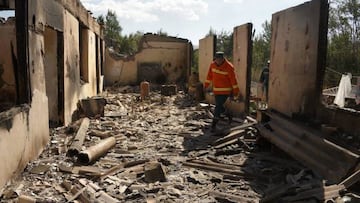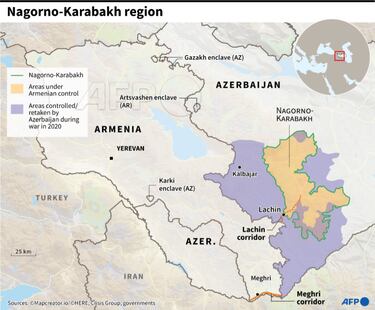The conflict between Armenia and Azerbaijan explained
Fighting has broken out in the contested Nagorno-Karabakh region, a landlocked area between Europe and Asia that is claimed by both countries.


As Ukrainian forces make progress on a fresh offensive against Russian invaders, another decades-old conflict in Eastern Europe is threatening to spark back into life.
On Tuesday morning fighting broke out on the border between Armenia and Azerbaijan in the disputed region of Nagorno-Karabakh. The Armenian Defense Ministry has claimed that Azerbaijani forces launched an artillery strike on the border towns of Goris, Sotk and Jermuk.
The Armenians allege that drones and large-calibre firearms were used on civilians, but their Azerbaijani counterparts have claimed that the strikes were “small-scale” efforts with the aim of ensuring “the security of Azerbaijan’s borders.”

What is the history of the Armenia – Azerbaijan conflict?
This dispute over the Nagorno-Karabakh region dates back to the 1920s, when modern-day Armenia and Azerbaijan were absorbed into the Soviet Union. The region itself was mostly populated by ethnic Armenians, but the Azerbaijani authorities were given control.
While under the umbrella of the Soviet Union there was little chance for conflict in the region, but with the Bloc beginning to falter in the late 1980s territorial disputes came to the surface.
Despite being designated as an Azerbaijani-controlled area, the regional parliament of Nagorno-Karabakh voted to become part of Armenia. The regional separatist movement, buoyed by the vote and backed by the Armenian government, clashed with Azerbaijani forces and a full-scale war broke out in the early 1990s.
Without Soviet forces to restore order fighting spread into civilian regions, with tens of thousands of people killed in ethnic cleanses. Massacres were committed by both sides and roughly a million people were displaced as a result.
By 1994 Armenian forces had gained a foothold in the Nagorno-Karabakh region and an international peace initiative, the Minsk Process, attempted to bring the conflict to a peaceful resolution. That year a Russian-led ceasefire was agreed but, with Armenians granted control of an area still claimed as sovereign land by Azerbaijan, the conflict has continued to bubble for the past three decades.
Fighting had broken out at various points since the 1994 peace agreement but 2020 saw the deadliest spate of violence since the 1990s. In November 2020 a two-month conflict left at least 6,500 people dead and sparked concern that the conflict was far from settled.
Two years ago Russia deployed peacekeeping forces to broker a ceasefire but after suffering losses in Ukraine, Russian assistance may not be so forthcoming this time.
Why is the conflicting restarting now?
As the dominant power in the region, Russia has long held a mediatory position in the conflict and helped broker a peace agreement in 2020 when fighting broke out in Nagorno-Karabakh. A statement from the Russian Foreign Ministry on Tuesday said that another ceasefire had been agreed.
“We call on the parties to refrain from further escalation of the situation, exercise restraint and strictly observe the ceasefire in accordance with the trilateral statements of the leaders of Russia, Azerbaijan and Armenia of November 9, 2020, January 11 and November 26, 2021,” a Russian foreign ministry statement said.
With Russia currently distracted by a huge Ukrainian military counter-offensive, it has been suggested that the Kremlin’s influence in Eastern Europe has weakened.
azerbaijan apparently shelling armenia all along the border—big escalation from fighting over contested territories.
— ian bremmer (@ianbremmer) September 12, 2022
russia, armenia’s closest (and nearly only) security partner, with more than its share of troubles presently. not a coincidence.
Related stories
Both Armenia and Azerbaijan were formed during the break-up of the Soviet Union. Moscow has retained a significant degree of influence in the decades since. However in the midst of a prolonged war in Ukraine, reports suggest that Azerbaijani forces may have been emboldened into launching an attack.
US Secretary of State Antony Blinken has called for an “adequate reaction” from world powers in response to the latest bout of violence, and demanded an “immediate cessation of hostilities.”

